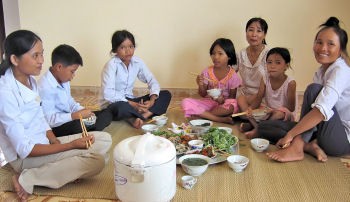Child Sponsorship background from Thanh Hoa, Vietnam
 SOS Children's Village Thanh Hoa
SOS Children's Village Thanh Hoa
According to official estimates, there are about 10,000 orphaned and abandoned children in Thanh Hoa province. The actual number is probably even higher. These children depend on being supported by their relatives or by the public. From early childhood on, they have to contribute towards earning their living. In rural areas, they usually take care of the animals, pick grass or look after their relatives' younger children. In the cities, they work in restaurants or pubs, they polish shoes or they sell newspapers. These children have neither enough time nor means to attend school. They face a life in poverty.
The local authorities approached SOS Children's Villages several times for help for the large number of children in need. Finally, the provincial government provided a piece of land for a new SOS Children's Village in the province capital of Thanh Hoa. Apart from that, the government has pledged its assistance in recruiting qualified co-workers.
SOS Children's Village Thanh Hoa consists of 14 family homes, staff accommodation, a community house, a house for the SOS aunts (SOS mother trainees and family helpers who support the SOS mothers) and the necessary administration and service area.
There is an SOS Nursery where up to 180 children can be taught in six group rooms. The nursery is attended by children from the SOS Children's Village and by children from the local community.
Background to Thanh Hoa
Thanh Hoa province is the second largest province of the country with an area of 11,200 sq. km. 70 per cent of the province is mountainous terrain. In the remote regions near the Laotian border, there is hardly any infrastructure. People there toil in the fields that hardly yield any crops. Spring tides often inundate the coastal areas on the Gulf of Tonkin in the east of the country during monsoon season. In 1996, more than 200 fishermen died during a hurricane, which caused heavy damage all over the region.
Thanh Hoa is one of Vietnam's poorest provinces, with an average per capita income far below that of the whole country. Local authorities try to attract investors to the industrial areas and achieved a respectable economic growth of 7.3% during the period from 1996 to 2000. However, there are by far not enough financial means to support the region's many needy children.

 Return to Schools Wikipedia Home page…
Return to Schools Wikipedia Home page…
